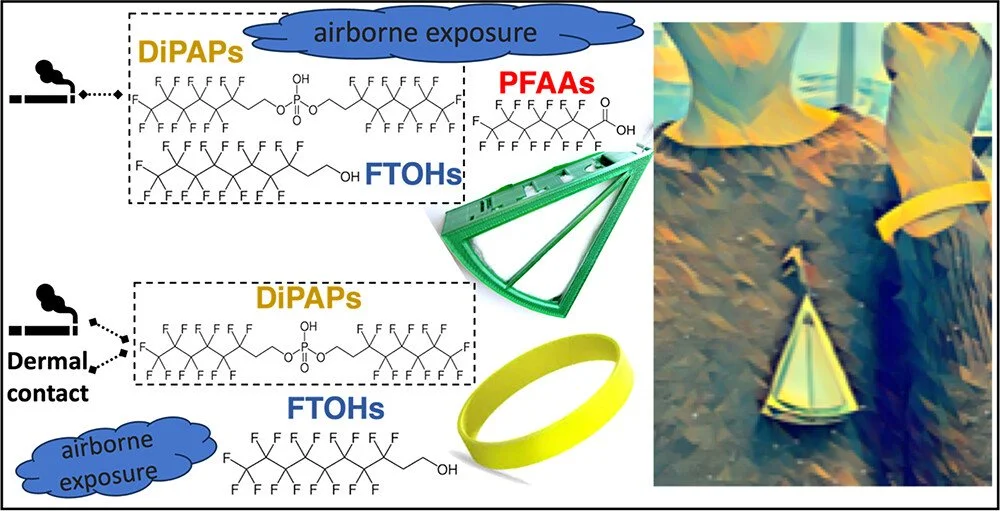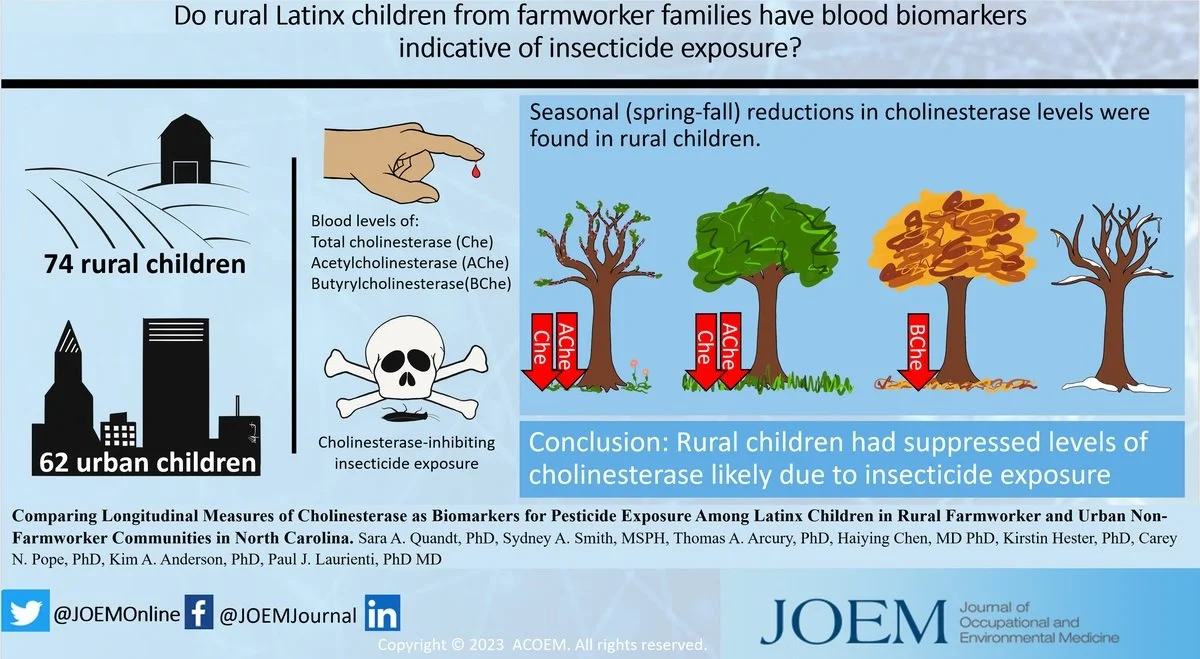Wristband personal samplers enable human exposure assessments for a diverse range of chemical contaminants and exposure settings with a previously unattainable scale and cost-effectiveness. Paired with nontargeted analyses, wristbands can provide important exposure monitoring data to expand our understanding of the environmental exposome. Here, a custom scripted suspect screening workflow was developed in the R programming language for feature selection and chemical annotations using gas chromatography–high-resolution mass spectrometry data acquired from the analysis of wristband samples collected from five different cohorts. The workflow includes blank subtraction, internal standard normalization, prediction of chemical uses in products, and feature annotation using multiple library search metrics and metadata from PubChem, among other functionalities. The workflow was developed and validated against 104 analytes identified by targeted analytical results in previously published reports of wristbands. A true positive rate of 62 and 48% in a quality control matrix and wristband samples, respectively, was observed for our optimum set of parameters. Feature analysis identified 458 features that were significantly higher on female-worn wristbands and only 21 features that were significantly higher on male-worn wristbands across all cohorts. Tentative identifications suggest that personal care products are a primary driver of the differences observed.
Exposure to per- and polyfluoroalkyl substances (PFASs) primarily occurs via consumption of contaminated drinking water and food; however, individuals can also be exposed dermally and via inhalation indoors. This study developed an analytical method for measuring volatile PFASs in silicone wristbands and used them to assess personal exposure in a Midwestern community (n = 87).
Accurate assessment of personal chemical exposures is critical to the advancement of environmental health sciences. Human biomonitoring of environmental chemicals has been traditionally considered as a gold standard, (Sexton et al., 2004) but many factors including costs, lab methods, and biospecimen storage and transport procedures can limit our ability to identify biomarkers that are sensitive, specific, and easy to measure (Mayeux, 2004). Biospecimen collection and storage under the proper conditions can be challenging and costly (Samon et al., 2022). Of particular concern for vulnerable populations including children, the collection of biospecimens may require invasive procedures such as an intravenous blood draw. Additionally, biomarkers for non-persistent chemicals with short half-lives may be unreliable without multiple samples and unreasonably short intervals between biospecimen collections (Aylward et al., 2014).
A novel approach to assess exposure to synthetic pyrethroids includes the use of silicone wristbands (WBs). In this pilot study completed on (n = 24) volunteers, comprising a week-long sampling period, paired urine samples (metabolites), and WBs (native compounds) were analyzed.
Ninety-two total chemicals were detected, with eight chemicals not previously reported in firefighter exposure studies. Based on the magnitude and frequency of increased exposure in on-duty dog tags, relative to paired off-duty dog tags, five PBDEs and sec-butylbenzene were identified as potential occupational exposures; sec-butylbenzene and PBDE 49 have not previously been reported in firefighter exposure studies to the authors' knowledge. Multivariate analyses for these six compounds indicated that firefighter rank, fire response rates, and years in the fire service were poor indicators of increased occupational exposure. The greatest on-duty exposures to PBDEs were found in the low-call volume department among operational firefighters. Dog tags from firefighters at the high-call volume department accounted for 75% of PCB detections; one particular fire response may have contributed to this. Additionally, there was measurable similarity in total chemical exposure profiles between paired on- and off-duty tags for some firefighters.
Due to differences in chemical properties and half-lives, best practices for exposure assessment may differ for legacy versus novel brominated flame retardants (BFRs). Our objective was to identify the environment matrix that best predicted biomarkers of children's BFR exposures. Paired samples were collected from children aged 3–6 years and their homes, including dust, a small piece of polyurethane foam from the furniture, and a handwipe and wristband from each child. Biological samples collected included serum, which was analyzed for 11 polybrominated diphenyl ethers (PBDEs), and urine, which was analyzed for tetrabromobenzoic acid (TBBA), a metabolite of 2-ethylhexyl-2,3,4,5-tetrabromobenzoate (EH-TBB).
In the United States and abroad, ortho-phthalates and non-ortho-phthalate plasticizers continue to be used within a diverse array of consumer products. Prior California-specific biomonitoring programs for ortho-phthalates have focused on rural, agricultural communities and, to our knowledge, these programs have not measured the potential for exposure to non-ortho-phthalate plasticizers. Therefore, the potential for human exposure to ortho-phthalates and non-ortho-phthalate plasticizers have not been adequately addressed in regions of California that have higher population density. Since there are numerous sources of ortho-phthalates and non-ortho-phthalate plasticizers in population-dense, urban regions, the objective of this study was to leverage silicone wristbands to quantify aggregate ortho-phthalate and non-ortho-phthalate plasticizer exposure over a 5-day period across two different cohorts (2019 and 2020) of undergraduate students at the University of California, Riverside (UCR) that commute from all over Southern California.
Exposures to polyaromatic hydrocarbons (PAHs) contribute to cancer in the fire service. Fire investigators are involved in evaluations of post-fire scenes. In the US, it is estimated that there are up to 9000 fire investigators, compared to approximately 1.1 million total firefighting personnel. This exploratory study contributes initial evidence of PAH exposures sustained by this understudied group using worn silicone passive samplers.
E-waste recycling is an increasingly important activity that contributes to reducing the burden of end-of-life electronic and electrical apparatus and allows for the EU's transition to a circular economy. This study investigated the exposure levels of selected persistent organic pollutants (POPs) in workers from e-waste recycling facilities across Europe.
The concentrations of seven polychlorinated biphenyls (PCBs) and eight polybrominated diphenyl ethers (PBDEs) congeners were measured by GC-MS. Workers were categorized into five groups based on the type of e-waste handled and two control groups. Generalized linear models were used to assess the determinants of exposure levels among workers. POPs levels were also assessed in dust and silicone wristbands (SWB) and compared with serum.
Silicone wristbands are a noninvasive personal exposure assessment tool. However, despite their utility, questions remain about the rate at which chemicals accumulate on wristbands when worn, as validation studies utilizing wristbands worn by human participants are limited. This study evaluated the chemical uptake rates of 113 organic pollutants from several chemical classes (i.e., polychlorinated biphenyls (PCB), organophosphate esters (OPEs), alkyl OPEs, polybrominated diphenyl ethers (PBDEs), brominated flame retardants (BFR), phthalates, pesticides, and polycyclic aromatic hydrocarbons (PAHs) over a five-day period.
This study was designed to determine if silicone wristbands provide a quantitative estimate of internal dose for phenols commonly associated with PCPs, with a focus on triclosan and four parabens: methyl-, ethyl-, propyl-, and butylparaben. Uptake of these compounds into wristbands and correlations with internal dose were assessed.
Polycyclic aromatic hydrocarbons (PAHs) pose health risks to children, potentially resulting in stunted growth, obesity, and cognitive deficits, but lack of reliable and noninvasive means to measure PAHs results in poor understanding of exposure patterns and sources in this vulnerable population. In this study, 24 children aged ∼7 years (9 boys and 15 girls) from Montevideo, Uruguay wore silicone wristbands for 8 days to monitor the exposure of 27 PAHs. Wristbands were extracted using a modified ethyl acetate tandem solid phase extraction clean up and then analyzed via gas chromatography with tandem mass spectrometry.
Plasticizers (PLs) and organophosphate flame retardants (OPFRs) are ubiquitous in the environment due to their widespread use and potential for leaching from consumer products. Environmental exposure is a critical aspect of the human exposome, revealing complex interactions between environmental contaminants and potential health effects. Silicone wristbands (SWBs) have emerged as a novel and non-invasive sampling device for assessing personal external exposure. In this study, SWBs were used as a proxy to estimate personal dermal adsorption (EDdermal) to PLs and OPFRs in Belgian participants for one week; four morning urine samples were also collected and analyzed for estimated daily intake (EDI).
Per- and polyfluoroalkyl substances (PFAS) are ubiquitously detected in the environment, raising concerns about human exposure. The assessment of individual exposure to PFAS has been limited due to the lack of specialized sampling tools. Personal wearable samplers, including silicone wristbands, have been used for PFAS exposure assessment.
Rural residents are exposed to both particulate and gaseous pesticides in the indoor-outdoor nexus in their daily routine. However, previous personal exposure assessment mostly focuses on single aspects of the exposure, such as indoor or gaseous exposure, leading to severe cognition bias to evaluate the exposure risks. In this study, residential dust and silicone wristbands (including stationary and personal wearing ones) were used to screen pesticides in different phases and unfold the hidden characteristics of personal exposure via indoor-outdoor nexus in intensive agricultural area. Mento-Carlo Simulation was performed to assess the probabilistic exposure risk by transforming adsorbed pesticides from wristbands into air concentration, which explores a new approach to integrate particulate (dust) and gaseous (silicone wristbands) pesticide exposures in indoor and outdoor environment.
Polycyclic aromatic hydrocarbons (PAHs) are an important component of urban air pollution. This study aimed to evaluate personal exposure to atmospheric PAHs in teachers working and residing in El Paso, Texas. Methods: Study participants carried air monitoring equipment in a backpack and wore silicone wristbands over a 24-hour period to serve as active and passive samplers, respectively. Results: Of the 25 PAHs measured, 23 compounds were detected in the filters, and 16 compounds were detected in the wristbands. Phenanthrene and naphthalene were the most abundant PAHs sequestered in both matrices. The filters captured more high molecular weight PAHs, whereas the wristbands captured more low molecular weight PAHs.
In a recent estimate, 96 million tons of hazardous waste were produced in the European Union, most of which were handled among the member states. Organophosphate esters (OPEs) are applied as flame retardants and plasticizers and are present in many products, e.g., electronics, which end up in the hazardous waste stream upon disposal. Given the growing body of information suggesting potential adverse health effects of OPEs, waste recycling workers who handle hazardous waste could potentially be at risk of elevated exposure to these chemicals.
Firefighters experience exposures to carcinogenic and mutagenic substances, including polycyclic aromatic hydrocarbons (PAHs). Silicone wristbands (SWBs) have been used as passive samplers to assess firefighters' exposures over the course of a shift but their utility in measuring short term exposures, source of exposure, and correlations with other measurements of exposure have not yet been investigated.
In a 2-group prospective design, this study compared seasonal cholinesterase levels of Latinx children in rural farmworker families and comparable urban children to assess the impact of environmental exposure to cholinesterase-inhibiting insecticides.
The intersectional risks of children in United States immigrant communities include environmental exposures. Pesticide exposures and their biological outcomes are not well characterized in this population group.




















